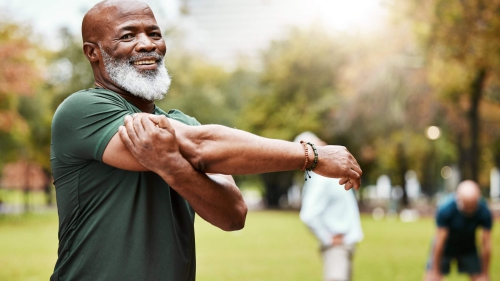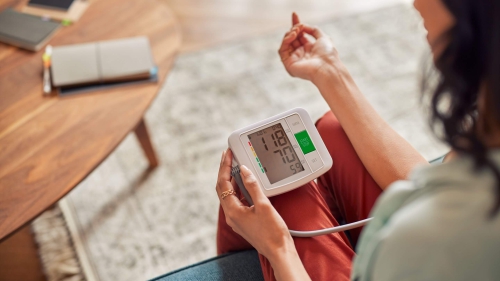Stand Against Sitting

Those of us whose jobs demand we sit at a desk for the better part of an eight- or ten-hour workday need to be diligent about taking a stand against sitting. The human body is a magnificent machine-like creation that functions at its best either standing upright on both feet or lying down to sleep, repair, and regenerate. In the last two centuries, and even more so in the last seventy years, our workday has shifted from manual labor to office jobs where we spend most of the day sitting in front of a computer.
Research increasingly tells us that too much time sitting can cause the early onset of health conditions from chronic neck, shoulder, and back pain; excess body fat; high blood sugar; high blood pressure; gastric distress; and restricted blood flow all the way to an increased risk of cardiovascular disease. It’s not all bad, though. Nowadays, people are less likely to be struck by cholera or smallpox than two hundred years ago. We now live longer, healthier lives, which means greater effort is required to stave off the conditions associated with inactivity. If you are one of the millions of Americans who sit all day at work, take a few precautionary steps during and after your workday to avoid chronic conditions that can result from a sedentary lifestyle.
When you first sit at your desk at the beginning of your workday, your posture is probably ideal. Your shoulders and chest are relaxed, your hip flexors and hamstrings are long and fresh, and you position yourself in a way that supports the natural curve of your spine. After about an hour, the muscles in the mid-back begin to tire, and for the next seven hours, they no longer fire properly. As these postural muscles tire, you slowly begin to slump and slouch. Your shoulders roll forward, shortening your chest muscles, and your chin angles downward as the muscles in your neck grow tired. If this isn’t bad enough, a similar situation is unfolding below your waist as your hip flexors and hamstrings shorten while you are seated. Over time these muscles weaken and begin pulling your pelvis forward, which causes pain in the lower back and hips. Spending long hours in unnatural and uncomfortable positions will eventually cause muscular imbalances. Tight muscles pulling too hard on a joint or weak muscles not pulling hard enough are prime causes of these imbalances.
If you are bothered by some of these conditions, it’s time to act. The first thing to consider will be your work station. According to the University of Michigan’s University Health Service, your desk chair should encourage the natural curve of your spine, and the seat should be cushioned and comfortable. Set your chair’s height so that your upper legs are parallel with and your lower legs are perpendicular to the floor. In this position, your feet will rest flat and comfortably on the floor. The chair must be a good match for your desk height to keep your elbows at about a ninety-degree angle while you’re using the keyboard and mouse. These items should be close enough to each other and to your body to avoid unnecessary, repetitive reaching. Lastly, position your monitor so that the top one-third of the screen is at eye level and at the right distance to read without squinting or tilting your head forward, straining your neck. With proper ergonomics, you can avoid the chronic conditions associated with poor desk posture.
Height-adjustable desks are a good alternative to their stationary counterparts, but what’s the right standing to sitting ratio? Depending on your current fitness level, a good starting point is 3:1. Each hour you can sit for forty-five minutes and stand for fifteen. As your feet and knees become used to standing more frequently, increase your standing time to as much as a 1:1 ratio. While standing, the position of your upper body relative to your work station should be similar to that while sitting. The top of your monitor should be at eye level, your keyboard and mouse should be at a height where your forearms can be positioned parallel to the floor, and your elbows should be relaxed near your sides. Place a cushioned mat below your feet and a small box or a riser nearby so you can elevate one foot from time to time to alleviate pressure on your back.
You’ve purchased the adjustable desk, and you’re following the 3:1 standing to sitting ratio, but you still notice yourself slouching. Don’t stress: it takes time for the body to adapt to new circumstances. If you are concerned, there are wearables that can monitor and correct your posture. Upper and lower posture correction braces wrap around your shoulders or midsection, making slouching feel uncomfortable and unnatural. Small electronic vibrating alarms can be attached to your clothing or worn in your breast pocket to give you a gentle (or not so gentle) vibrating reminder to adjust your stance if your posture begins to slump. Add these to the list of potential options to help during your workday, then adjust your focus to your time outside of work hours.
Blaming the global obesity epidemic on the office working environment would be a stretch. However, according to Dr. Edward R. Laskowski at Mayo Clinic, “An analysis of 13 studies of sitting time and activity levels found that those who sat for more than eight [total] hours a day with no physical activity had a risk of dying similar to the risks of dying posed by obesity and smoking.” Can we really call sitting the new smoking? The data from these thirteen studies involved more than a million people and found that about sixty minutes a day of moderately intense physical activity counters the harmful effects of too much sitting. That’s more than double the 150 minutes per week recommended by both the American Heart Association and the Centers for Disease Control and Prevention, so get up and get moving.
Aches and pains associated with too much sitting are typically caused by either tight or shortened muscles. Muscles that are regularly shortened for extended periods need to be stretched. The chest and hamstrings are two large muscle groups that become shortened while seated at a desk, and these large muscles are common causes of pain for office workers. Stretch your chest by raising your arms over your head, bending your elbows, and interlocking your fingers behind your head. Squeeze your shoulder blades together and pull your elbows backwards. Stop pulling back when you feel resistance from chest muscles, and hold that position for fifteen to twenty seconds. Release the stretch, unlock your fingers, and reach for the sky with your arms positioned as if your body was the letter Y. Push your hips forward a bit to add your abdominal muscles into the stretch.
You continuously use postural and core muscles while in the seated position. Strengthen these muscles so that they can continue firing properly throughout the day to prevent slouching. Upper and lower back pain, as well as lower body nerve pain, can be lessened or sometimes even eliminated by a strong, well-balanced core. The erector spinae are a group of muscles that run along the spine or midline of the back. These muscles are responsible for keeping us standing and sitting tall.
The Bird Dog is a great core exercise to help with strength and balance. To do the Bird Dog,
- Position yourself on all fours with your palms on the floor directly below your shoulders and your knees on the floor underneath your hips at the same width as your hands.
- Slowly raise your right arm, pointing your thumb to the ceiling until your arm is parallel with your body, while simultaneously kicking your left leg back until it is parallel with the floor. Squeeze your entire core to keep balanced while moving to and holding the pointing position.
- Hold the pointing position for five to fifteen seconds, then bring your arm and leg back towards the starting point. Stop right before your hand and knee touch the floor.
- Repeat for five to eight repetitions.
- Move onto the left arm and right leg for two sets on each side. Cycle through this routine two to three times a week.
Don’t feel embarrassed when you topple over; it happens to the best of us.
If you can take short breaks during your workday, your body will thank you. Push back from your desk every thirty minutes to stand up and shake both your hands in the air. Then shake your legs one at a time to enhance blood circulation to your extremities. The seated position causes constriction at points throughout the body and can sometimes restrict normal bodily functions.
According to a study by R. Dainese et al. in the journal Gut, one point of constriction is in your digestive tract. In this study, gas was infused into the participants, then collected as it was evacuated. (I hope they were well compensated). The study found that body posture affects the intestinal transit of gas. In particular, standing in the upright position had a beneficial effect on the movement of intestinal gases. When sitting, these gases do not move through the body as freely, and the buildup can cause stomach pain, bloating, and abdominal distension.
As pressure builds inside your stomach, you search for a more comfortable position, potentially by crossing your legs. This takes pressure off of the abdominal area but restricts blood flow below the point of your crossed legs. Numbness, commonly described as a “pins and needles” sensation, lets you know that it’s time to change positions. You and I know what that really means: it’s time to stand tall and shake it out.
You’ve set up your workstation as ergonomically as possible, and every thirty minutes you’re standing up and shaking. Your coworkers may be looking at you funny, but you notice that your stiffness is gone. In a way, our bodies are similar to cars. When you start your car in the winter, the entire car is cold while the engine oil is still thick and slow. If you leave the car running for five minutes, the cold air coming through the vents gets warm, and the engine quiets down. If you went outside and started your car every half hour, it would cost you a small fortune in fuel, but your car would never be cold. Treat your body the same way. Keep it functioning at its peak by incorporating regular movement into your workday.
Once every few hours, you should stand up and take about two minutes to exercise in front of your computer. Neck circles, chin tucks, shoulder raises, shoulder circles, arm circles, arm swings, finger fans, arm shakes, leg shakes, toe curls, toe touches, and even eye rolls will help lubricate stiff joints, relax strained muscles, and stretch shortened ones. Personalize your work station so that you feel comfortable and rested while at your desk. Consult with your physician before introducing a routine to stretch and strengthen, and find a fitness professional to guide and motivate you through the beginning stages. Don’t worry about the strange looks you get from your coworkers: before long, they’ll join you in your stand against sitting.
Ali Othman has been an NSCA-certified personal trainer for the past fourteen years with specialization in weight loss, functional training, muscular hypertrophy, and human nutrition. He also works in the Technical Department at IFANCA and manages IFANCA business activities in South Korea.
Reprinted from the Winter 2020 issue of Halal Consumer© magazine with permission from the Islamic Food and Nutrition Council of America (IFANCA®) and Halal Consumer© magazine.

















